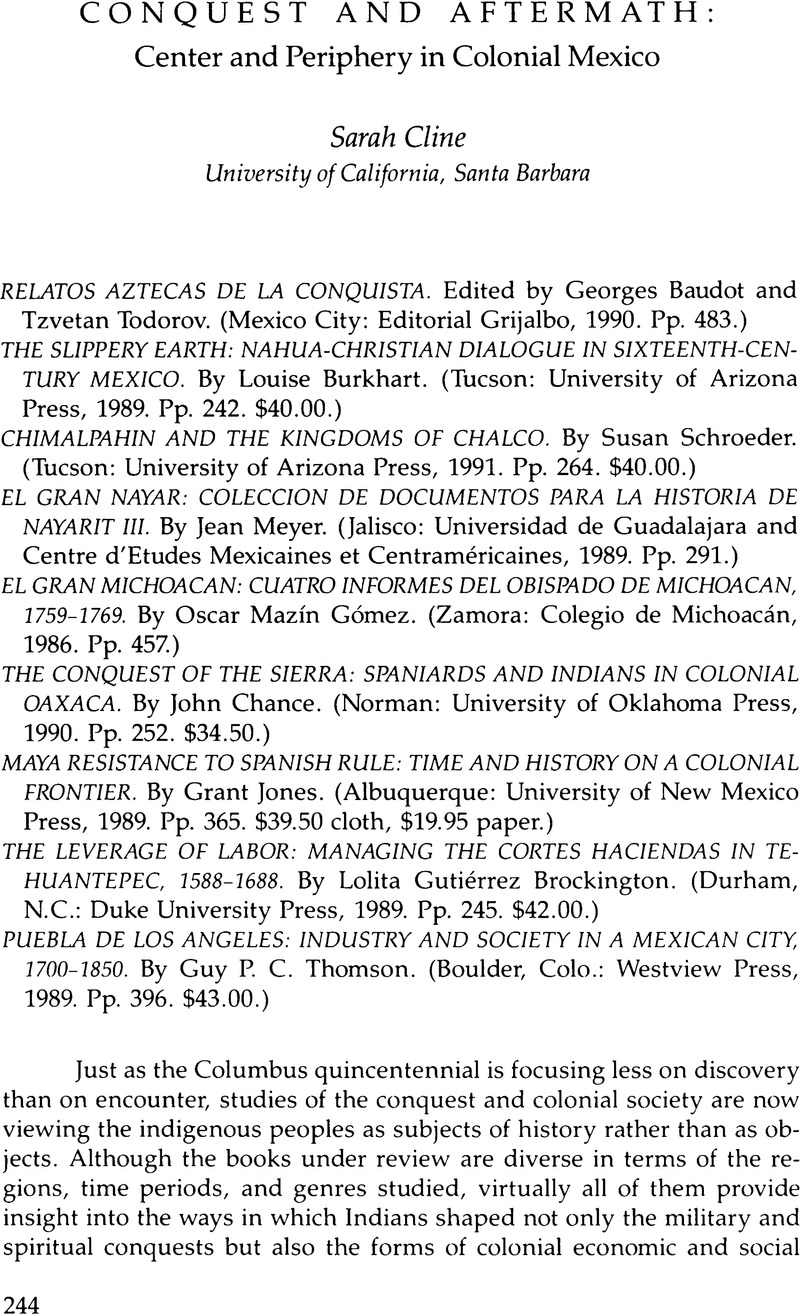Published online by Cambridge University Press: 12 October 2022

1. Bernardino de Sahagún, The Florentine Codex (Salt Lake City: University of Utah Press, 1950–1982).
2. Susan Gillespie, The Aztec Kings: The Construction of Rulership in Mexican History (Tucson: University of Arizona Press, 1989).
3. Bernardino de Sahagún, The Conquest of New Spain, 1585 Revision (Salt Lake City: University of Utah Press, 1989).
4. Robert Ricard, The Spiritual Conquest of Mexico (Berkeley and Los Angeles: University of California Press, 1966).
5. See the following works by J. Jorge Klor de Alva: “Spiritual Conflict and Accommodation in New Spain: Toward a Typology of Aztec Responses to Christianity,” in The Inca and Aztec States, edited by George A. Collier, Renato I. Rosaldo, and John D. Wirth (New York: Academic Press, 1982), 345–66; “Language, Politics, and Translation: Colonial Discourse and Classic Nahuatl in New Spain,” in The Art of Translation: Voices from the Field, edited by Rosanna Warren (Boston, Mass.: Northeastern University Press, 1989), 143–62; “Contar vidas: la autobiografía confesional y la reconstrucción del ser nahua,” Arbor, nos. 515–16 (1988):49–78; and his work in progress entitled “The Confession of the Other: Aztec Sins and the Birth of Anthropology.”
6. Charles Gibson, The Aztecs under Spanish Rule (Palo Alto, Calif.: Stanford University Press, 1964).
7. James Lockhart, Frances Berdan, and Arthur J. O. Anderson, The Tlaxcalan Actas: A Compendium of Records of the Cabildo of Tlaxcala, 1545–1627 (Salt Lake City: University of Utah Press, 1986); S. L. Cline and Miguel León-Portilla, The Testaments of Culhuacan, Nahua Studies Series no. 1 (Los Angeles: UCLA Latin American Center Publications, 1984); and Aztekischer Zensus: Zur indianischen Wirtschaft und der Gesellschaft im Marquesado um 1540, Aus dem “Libro de Tributos” (Col. Ant. Ms. 551) im Archivo Histórico, Mexico, 2 vols., edited by Eike Hinz, Claudine Hartau, and Marie-Luise Heimann-Koenen (Hannover: Verlag für Ethnologie, 1983). Analyses of Nahua society based on native-language documentation include S. L. Cline, Colonial Culhuacan, 1580–1600: A Social History of an Aztec Town (Albuquerque: University of New Mexico Press, 1986); Robert Haskett, Indigenous Rulers: An Ethnohistory of Town Government in Colonial Cuernavaca (Albuquerque: University of New Mexico Press, 1991); and James Lockhart, The Nahuas after the Conquest (Stanford University Press, forthcoming).
8. Brian Hamnett, Trade and Politics in Southern Mexico, 1750–1821 (Cambridge: Cambridge University Press, 1971).
9. Inga Clendennin, Ambivalent Conquests (Cambridge: Cambridge University Press, 1987); and Nancy Farriss, Maya Society under Colonial Rule (Princeton, N.J.: Princeton University Press, 1984).
10. Judith Francis Zeitlin, “Ranchers and Indians on the Southern Isthmus of Tehuantepec: Economic Change and Indigenous Survival in Colonial Mexico,” Hispanic American Historical Review 69, no. 1 (Feb. 1989):23–60.
11. Bernardo García Martínez, Los pueblos de la Sierra: el poder y espacio entre los indios del norte de Puebla hasta 1700 (Mexico City: Colegio de México, 1987).
12. David A. Brading, Miners and Merchants in Bourbon Mexico, 1763–1810 (Cambridge: Cambridge University Press, 1971); and Peter Bakewell, Silver Mining and Society in Colonial Mexico: Zacatecas, 1546–1700 (Cambridge: Cambridge University Press, 1971).
13. For comparison with Mexico City merchants, see John Kicza, Colonial Entrepreneurs: Families and Business in Bourbon Mexico City (Albuquerque: University of New Mexico Press, 1983).
14. For another study that spans two eras and deals specifically with women, see Silvia Arrom, The Women of Mexico City (Palo Alto, Calif.: Stanford University Press, 1985).